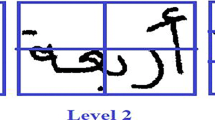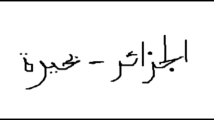Abstract
The research community considers handwritten word recognition (HWR) as an open research problem to date. The reasons behind this are variations in intra-/interpersonal writing style, overlapping and/or touching characters in a word, degraded scanned document images, etc. Two major approaches, namely holistic and analytical, are followed by the researchers while designing an HWR system. In this work, we have followed the holistic approach as it works well on limited and pre-defined lexicon as compared to the analytical approach. As observed in the literature related to handwritten word recognition, irrespective of the approaches, researchers generally extract various local features from hypothetically partitioned segments of a word image while dealing with the said problem. However, no such work has been found which has considered inter-segment similarity that might carry some distinct information about different patterns (here, word segments). To this end, in the present work, we have used Hausdorff and Fréchet distances to quantize the similarity among all possible word segments taking two at a time. Along with this, conventional chain code histogram (a shape-based feature descriptor) and modified negative refraction-based shape transformation features have been used. Finally, a majority voting schema is used to combine outputs from six different classifiers. The model has been evaluated on two standard databases, namely IAM and IFN/ENIT, and the results obtained are promising in comparison with state-of-the-art holistic word recognition methods. Moreover, a performance comparison of the present method with some deep learning models confirms the usefulness of the proposed method.


























Similar content being viewed by others
Explore related subjects
Discover the latest articles, news and stories from top researchers in related subjects.References
Pal, U., Roy, R.K., Kimura, F.: Multi-lingual city name recognition for Indian postal automation. In: Proceedings of the International Workshop on Frontiers in Handwriting Recognition. pp. 169–173. IEEE (2012)
Pal, U., Roy, K., Kimura, F.: A lexicon-driven handwritten city-name recognition scheme for Indian postal automation. IEICE Trans. Inf. Syst. E92-D, 1146–1158 (2009). https://doi.org/10.1587/transinf.E92.D.1146
Singh, S., Kariveda, T., Gupta, J. Das, Bhattacharya, K.: Handwritten words recognition for legal amounts of bank cheques in English script. In: Proceeding of the 2015 8th International Conference on Advances in Pattern Recognition. pp. 1–5. IEEE (2015)
Jayadevan, R., Kolhe, S.R., Patil, P.M., Pal, U.: Database development and recognition of handwritten Devanagari legal amount words. In: Proceedings of the International Conference on Document Analysis and Recognition (ICDAR). pp. 304–308. IEEE (2011)
Malakar, S., Ghosh, M., Sarkar, R., Nasipuri, M.: Development of a two-stage segmentation-based word searching method for handwritten document images. J. Intell. Syst. 29, 719–735 (2020). https://doi.org/10.1515/jisys-2017-0384
Majumder, S., Ghosh, S., Malakar, S., Sarkar, R., Nasipuri, M.: A voting-based technique for word spotting in handwritten document images. Multimed. Tools Appl. (2021). https://doi.org/10.1007/s11042-020-10363-0
Kundu, S., Malakar, S., Geem, Z.W., Moon, Y.Y., Singh, P.K., Sarkar, R.: Hough transform-based angular features for learning-free handwritten keyword spotting. Sensors 21, 4648 (2021)
Mondal, R., Malakar, S., Barney Smith, E.H., Sarkar, R.: Handwritten English word recognition using a deep learning based object detection architecture. Multimed. Tools Appl. 81, 975–1000 (2022)
Bhattacharya, R., Malakar, S., Schwenker, F., Sarkar, R.: Fuzzy-based pseudo segmentation approach for handwritten word recognition using a sequence to sequence model with attention. In: Pattern recognition. ICPR international workshops and challenges: virtual event, January 10–15, 2021, Proceedings, Part II, pp. 582–596. Springer (2021)
Majid, N., Smith, E.H.B.: Segmentation-free bangla offline handwriting recognition using sequential detection of characters and diacritics with a Faster R-CNN. In: 2019 international conference on document analysis and recognition (ICDAR), pp. 228–233. IEEE (2019)
Amrouch, M., Rabi, M., Mammass, D.: An improved Arabic handwritten recognition system using embedded training based on HMMs. In: 2016 IEEE/ACS 13th international conference of computer systems and applications (AICCSA), pp 1–5. IEEE (2016)
Mahjoub, M.A., Ghanmy, N., Miled, I.: Multiple models of Bayesian networks applied to offline recognition of Arabic handwritten city names. arXiv Prepr. http://arxiv.org/abs/1301.4377. (2013)
Dasgupta, J., Bhattacharya, K., Chanda, B.: A holistic approach for Off-line handwritten cursive word recognition using directional feature based on Arnold transform. Pattern Recognit. Lett. 79, 73–79 (2016). https://doi.org/10.1016/j.patrec.2016.05.017
Malakar, S., Sarkar, R., Basu, S., Kundu, M., Nasipuri, M.: An image database of handwritten Bangla words with automatic benchmarking facilities for character segmentation algorithms. Neural Comput. Appl. 33, 449–468 (2021). https://doi.org/10.1007/s00521-020-04981-w
Inunganbi, S., Choudhary, P., Manglem, K.: Meitei Mayek handwritten dataset: compilation, segmentation, and character recognition. Vis. Comput. 37, 291–305 (2021)
Madhvanath, S., Govindaraju, V., Member, S.: The role of holistic paradigms in handwritten word recognition. IEEE Trans. Pattern Anal. Mach. Intell. 23, 149–164 (2001)
Hijam, D., Saharia, S.: On developing complete character set meitei mayek handwritten character database. Vis. Comput. 1–15 (2021)
Guo, H., Liu, Y., Yang, D., Zhao, J.: Offline handwritten Tai Le character recognition using ensemble deep learning. Vis. Comput. 1–14 (2021)
Ghosh, S., Chatterjee, A., Singh, P.K., Bhowmik, S., Sarkar, R.: Language-invariant novel feature descriptors for handwritten numeral recognition. Vis. Comput. 37, 1781–1803 (2021)
Chatterjee, A., Malakar, S., Sarkar, R., Nasipuri, M.: Handwritten digit recognition using DAISY descriptor: a study. In: Proceedings of 5th international conference on emerging applications of information technology (EAIT 2018), pp. 1–4. (2018)
Warrington, E.K., Shallice, T.: Word-form dyslexia. Brain 103, 99–112 (1980)
Madhvanath, S.: Holistic verification of handwritten phrases. IEEE Trans. Pattern Anal. Mach. Intell. 21, 1344–1356 (1999). https://doi.org/10.1109/34.817412
Kacem, A., Aouïti, N., Belaïd, A.: Structural features extraction for handwritten Arabic personal names recognition. In: 2012 international conference on frontiers in handwriting recognition, pp. 268–273. IEEE (2012)
Khémiri, A., Kacem, A., Belaïd, A.: Towards arabic handwritten word recognition via probabilistic graphical models. In: 2014 14th international conference on frontiers in handwriting recognition, pp. 678–683. IEEE (2014)
Khémiri, A., Echi, A.K., Belaïd, A., Elloumi, M.: A system for off-line Arabic handwritten word recognition based on Bayesian approach. In: 2016 15th international conference on frontiers in handwriting recognition (ICFHR), pp. 560–565. IEEE (2016)
AlKhateeb, J.H., Khelifi, F., Jiang, J., Ipson, S.S.: A new approach for off-line handwritten Arabic word recognition using KNN classifier. In: 2009 IEEE International Conference on Signal and Image Processing Applications. pp. 191–194. IEEE (2009)
Tamen, Z., Drias, H., Boughaci, D.: An efficient multiple classifier system for Arabic handwritten words recognition. Pattern Recognit. Lett. 93, 123–132 (2017). https://doi.org/10.1016/j.patrec.2017.01.020
Al-Nuzaili, Q.A., Hashim, S.Z.M., Saeed, F., Khalil, M.S., Mohamad, D.: Bin: Pixel distribution-based features for offline Arabic handwritten word recognition. Int. J. Comput. Vis. Robot. 7, 99–122 (2017)
Hassen, H., Al-Maadeed, S.: Arabic handwriting recognition using sequential minimal optimization. In: 2017 1st international workshop on arabic script analysis and recognition (ASAR), pp 79–84. IEEE (2017)
Cajote, R.D., Guevara, R.C.L.: Global word shape processing using polar-radii graphs for offline handwriting recognition. In: 2004 IEEE Region 10 Conference TENCON 2004, pp. 315–318. IEEE (2004)
Gatos, B., Pratikakis, I., Perantonis, S.J.: Hybrid off-line cursive handwriting word recognition. In: 18th International Conference on Pattern Recognition (ICPR’06), pp. 998–1002. IEEE (2006)
Bianne-Bernard, A.-L., Menasri, F., Mohamad, R.A.-H., Mokbel, C., Kermorvant, C., Likforman-Sulem, L.: Dynamic and contextual information in HMM modeling for handwritten word recognition. IEEE Trans. Pattern Anal. Mach. Intell. 33, 2066–2080 (2011)
Sahoo, S., Nandi, S.K., Barua, S., Priyam, P., Bhowmik, S., Malakar, S., Sarkar, R.: Handwritten Bangla word recognition using negative refraction based shape transformation. J. Intell. Fuzzy Syst. 35, 1765–1777 (2018)
Malakar, S., Ghosh, M., Bhowmik, S., Sarkar, R., Nasipuri, M.: A GA based hierarchical feature selection approach for handwritten word recognition. Neural Comput. Appl. 32, 2533–2552 (2020)
Bhowmik, S., Malakar, S., Sarkar, R., Nasipuri, M.: Handwritten bangla word recognition using elliptical features. In: Proceedings - 2014 6th International Conference on Computational Intelligence and Communication Networks, CICN 2014, pp. 257–261. IEEE (2014)
Barua, S., Malakar, S., Bhowmik, S., Sarkar, R., Nasipuri, M.: Bangla handwritten city name recognition using gradient-based feature. In: 5th international conference on frontiers in intelligent computing: theory and applications, pp. 343–352. Springer, Singapore (2017)
Bhowmik, S., Malakar, S., Sarkar, R., Basu, S., Kundu, M., Nasipuri, M.: Off-line Bangla handwritten word recognition: a holistic approach. Neural Comput. Appl. 31, 5783–5798 (2019)
Malakar, S., Sharma, P., Singh, P.K., Das, M., Sarkar, R., Nasipuri, M.: A holistic approach for handwritten hindi word recognition. Int. J. Comput. Vis. Image Process. 7, 59–78 (2017). https://doi.org/10.4018/IJCVIP.2017010104
Jino, P.J., Balakrishnan, K.: Offline handwritten recognition of malayalam district name-a holistic approach. Int. J. Eng. Technol. 9, 987–994 (2017)
Kaur, H., Kumar, M.: Offline handwritten Gurumukhi word recognition using eXtreme Gradient Boosting methodology. Soft Comput. 1–14 (2020)
Ruiz-Pinales, J., Jaime-Rivas, R., Castro-Bleda, M.J.: Holistic cursive word recognition based on perceptual features. Pattern Recognit. Lett. 28, 1600–1609 (2007). https://doi.org/10.1016/j.patrec.2007.03.017
Awni, M., Khalil, M.I., Abbas, H.M.: Deep-learning ensemble for offline Arabic handwritten words recognition. In: 2019 14th International Conference on Computer Engineering and Systems (ICCES), pp. 40–45. IEEE (2019)
Essa, N., El-Daydamony, E., Mohamed, A.A.: Enhanced technique for Arabic handwriting recognition using deep belief network and a morphological algorithm for solving ligature segmentation. ETRI J. 40, 774–787 (2018)
Malakar, S., Paul, S., Kundu, S., Bhowmik, S., Sarkar, R., Nasipuri, M.: Handwritten word recognition using lottery ticket hypothesis based pruned CNN model: a new benchmark on CMATERdb2. 1.2. Neural Comput. Appl. 32, 15209–15220 (2020)
Pramanik, R., Bag, S.: Handwritten Bangla city name word recognition using CNN-based transfer learning and FCN. Neural Comput. Appl. 33, 9329–9341 (2021)
Das, D., Nayak, D.R., Dash, R., Majhi, B., Zhang, Y.-D.: H-WordNet: a holistic convolutional neural network approach for handwritten word recognition. IET Image Process. 14, 1794–1805 (2020)
Malakar, S., Mohanta, D., Sarkar, R., Das, N., Nasipuri, M., Basu, D.K.: Binarization of the noisy document images: a new approach. In: International Conference on Information Processing, pp. 511–520. (2011)
Pechwitz, M., Maddouri, S.S., Märgner, V.: IFN/ENIT-database of handwritten Arabic words. In: Francophone International Conference on writing and Document, pp. 127–136. Citeseer (2002)
IAM On-Line Handwriting Database, http://www.fki.inf.unibe.ch/databases/iam-on-line-handwriting-database
Zimmermann, M., Bunke, H.: Automatic segmentation of the IAM off-line database for handwritten English text. In: Object Recognition Supported by User Interaction for Service Robots. pp. 35–39. IEEE (2002)
Sahoo, S., Nandi, S.K., Barua, S., Priyam, P., Malakar, S., Sarkar, R.: Handwritten Bangla city name recognition using shape-context feature. In: 6th International Conference on Frontiers in Intelligent Computing: Theory and Applications, pp. 451–460. Springer, Singapore (2018)
Mohamed, I.: The application of negative refractive index metamaterials to mm and sub-mm wave-length instrumentation (2013)
Rucklidge, W.: The hausdorff distance. In: Rucklidge, W. (ed.) Efficient Visual Recognition Using the Hausdorff Distance, pp. 27–42. Springer, Berlin, Heidelberg (1996)
Zhu, L., Zhu, C.: Application of Hausdorff distance in image matching. In: 2014 IEEE Workshop on Electronics, Computer and Applications, pp. 97–100. IEEE (2014)
Eiter, T., Mannila, H.: Computing discrete Fréchet distance. Citeseer (1994)
Kundu, S., Paul, S., Singh, P.K., Sarkar, R., Nasipuri, M.: Understanding NFC-Net: a deep learning approach to word-level handwritten Indic script recognition. Neural Comput. Appl. 32, 1–17 (2020)
Fan, Y., Rui, X., Poslad, S., Zhang, G., Yu, T., Xu, X., Song, X.: A better way to monitor haze through image based upon the adjusted LeNet-5 CNN model. Signal Image Video Process. 14, 455–463 (2020)
Krizhevsky, A., Sutskever, I., Hinton, G.E.: Imagenet classification with deep convolutional neural networks. In: Advances in Neural Information Processing Systems, pp. 1097–1105 (2012)
Acknowledgements
We would like to thank the Center for Microprocessor Applications for Training Education and Research (CMATER) research laboratory of the Computer Science and Engineering Department, Jadavpur University, Kolkata, India, for providing us the infrastructural support.
Author information
Authors and Affiliations
Corresponding author
Ethics declarations
Conflict of interest
We declare that we have no conflict of interest.
Additional information
Publisher's Note
Springer Nature remains neutral with regard to jurisdictional claims in published maps and institutional affiliations.
Rights and permissions
About this article
Cite this article
Malakar, S., Sahoo, S., Chakraborty, A. et al. Handwritten Arabic and Roman word recognition using holistic approach. Vis Comput 39, 2909–2932 (2023). https://doi.org/10.1007/s00371-022-02500-7
Accepted:
Published:
Issue Date:
DOI: https://doi.org/10.1007/s00371-022-02500-7




